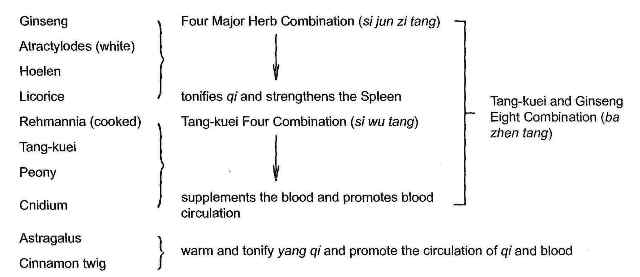Commonly Used Chinese Herb Formulas with Illustrations - Ginseng and Dang Gui Ten Combination (Shi Quan Da Bu Tang)
0215 十全大補湯 (Shi Quan Da Bu Tang)
Ginseng & Dang Gui Ten Combination
All-Inclusive Great Tonifying Decoction
【Formulation】
|
Chinese Name |
Pharmaceutical Name |
Pin Yin Name |
English Name |
|
茯苓 |
Poria |
Fu Ling |
|
|
白朮 |
Rhizoma Atractylodis macrocephalae |
Bai Zhu |
|
|
人參 |
Radix Ginseng |
Ren Shen |
|
|
熟地黃 |
Radix Rehmanniae praeparata |
Shu Di Huang |
|
|
白芍 |
Radix Paeoniae alba |
Bai Shao |
|
|
炙甘草 |
Radix Glycyrrhizae praeparata cum melle |
Zhi Gan Cao |
|
|
黃耆 |
Radix Astragali |
Huang Qi |
|
|
肉桂 |
Cortex Cinnamomi |
Rou Gui |
|
|
當歸 |
Radix Angelicae sinensis |
Dang Gui |
|
|
川芎 |
Rhizoma Chuanxiong |
Chuan Xiong |
|
|
生薑 |
Rhizoma Zingiberis recens |
Sheng Jiang |
|
|
大棗 |
Fructus Jujubae |
Da Zao |
【Classic Literature Reference】
Tai Ping Hui Min He Ji Ju Fang (Formulas of the Bureau of the People's Welfare Pharmacy,
1078).
Compiler: Chen, Shi-wen, et al.
【Indications】
Traditional: Qi and blood deficiency marked by a low energy level, shortness of breath, palpitation, insomnia, dizziness, poor appetite, chronic cough, weak and cold limbs, pale and sallow complexion, emaciation, heavy menstrual bleeding, chronic ulceration, a pale tongue, and a thready and weak pulse.
Modern: Debility following illness, childbirth, or surgery; anemia due to excessive bleeding; cancer; side effects due to chemotherapy or radiation; chronic atrophic gastritis; gastroptosis; leukopenia; Sheehan's syndrome; Meniere's disease; and hypoalbuminemia.

Pattern of Both Qi and Blood Deficiencies
【Herbs and Actions】

Join our member to get full-text article! Join Free!
【Pharmacological Studies】for members only
【Clinical Applications】for members only
【Precaution & Contraindications】for members only
【Discriminations】for members only
【References】for members only